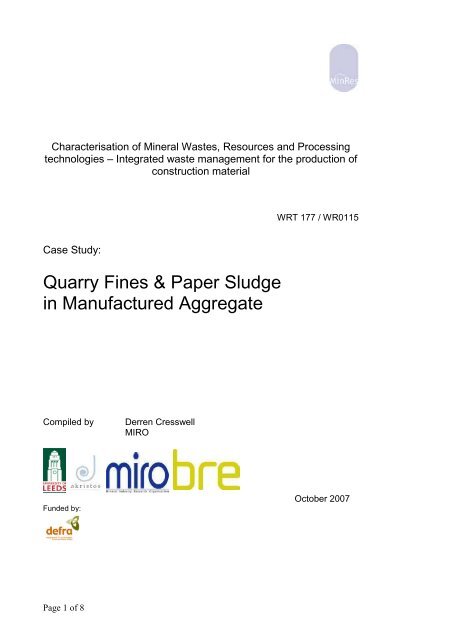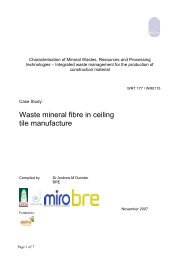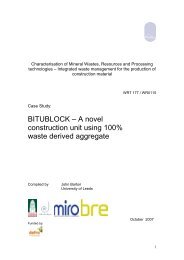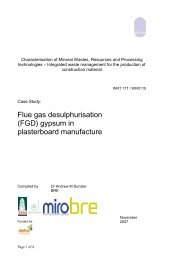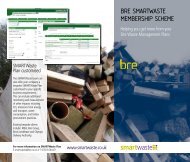Quarry Fines & Paper Sludge in Manufactured ... - SMARTWaste
Quarry Fines & Paper Sludge in Manufactured ... - SMARTWaste
Quarry Fines & Paper Sludge in Manufactured ... - SMARTWaste
Create successful ePaper yourself
Turn your PDF publications into a flip-book with our unique Google optimized e-Paper software.
Characterisation of M<strong>in</strong>eral Wastes, Resources and Process<strong>in</strong>gtechnologies – Integrated waste management for the production ofconstruction materialWRT 177 / WR0115Case Study:<strong>Quarry</strong> <strong>F<strong>in</strong>es</strong> & <strong>Paper</strong> <strong>Sludge</strong><strong>in</strong> <strong>Manufactured</strong> AggregateCompiled byDerren CresswellMIROFunded by:October 2007Page 1 of 8
Introduction<strong>Quarry</strong> <strong>F<strong>in</strong>es</strong><strong>Quarry</strong> f<strong>in</strong>es are a category of material vary depend<strong>in</strong>g on the operations and type of primaryresource be<strong>in</strong>g quarried. They can be classified <strong>in</strong>to two ma<strong>in</strong> groups:• Crushed rock f<strong>in</strong>es• Sand and gravel wash<strong>in</strong>gsCrushed rock f<strong>in</strong>es are the material that cannot f<strong>in</strong>d a use <strong>in</strong> the local market. It is usually thefraction of material under 4mm. This upper limit varies depend<strong>in</strong>g on location. Traditionally thisfraction would accompany coarser material <strong>in</strong> the provision of well graded fill material for civileng<strong>in</strong>eer<strong>in</strong>g works. However changes <strong>in</strong> the market <strong>in</strong>clud<strong>in</strong>g greater use of recycled andsecondary aggregate and changes <strong>in</strong> the coarser size requirements especially <strong>in</strong> road constructionhave led to such f<strong>in</strong>es not be<strong>in</strong>g economic given the £1.90 per tonne Aggregates Levy. Thesematerials can be screened and washed to provide some sand however this aga<strong>in</strong> depends on localmarkets. The composition will be the same as the rock that is be<strong>in</strong>g crushed. In the case oflimestone it will therefore be calcium carbonate (CaCO 3 ), <strong>in</strong> the case sandstone I will bepredom<strong>in</strong>antly silica (SiO 2 ) and for igneous rock it will be silica and feldspars and smaller amountsof mica and hornblende.Sand and gravel wash<strong>in</strong>gs are silt and clay material that occur <strong>in</strong> the same deposit as the sand andgravel required for aggregates. The aggregate is screened and often washed to separate the f<strong>in</strong>ersilt and sand fraction. Usually this material is the fractions pass<strong>in</strong>g 150µm with the majority pass<strong>in</strong>g75µm. The composition of the wash<strong>in</strong>gs will vary depend<strong>in</strong>g on the locality but will be composed ofCa, Mg, Al silicates.<strong>Paper</strong> <strong>Sludge</strong><strong>Paper</strong> mill sludge is a major economic and environmental problem for the paper and board<strong>in</strong>dustry. The material is a by-product of the de-<strong>in</strong>k<strong>in</strong>g and re-pulp<strong>in</strong>g of paper. The total quantity ofpaper mill sludge produced <strong>in</strong> the UK annually is approximately 1 million tonnes (1). The ma<strong>in</strong>recycl<strong>in</strong>g and disposal routes for paper sludge are land-spread<strong>in</strong>g as agricultural fertiliser,<strong>in</strong>c<strong>in</strong>eration <strong>in</strong> CHP plants at the paper mill, produc<strong>in</strong>g paper sludge ash, or disposal to landfill. Thescope for landfill spread<strong>in</strong>g is limited and is covered by an <strong>in</strong>dustry code of practice (2,3).In functional terms, paper sludge consists of cellulose fibres, fillers such as calcium carbonate andch<strong>in</strong>a clay and residual chemicals bound up with water. The moisture content is typically up to40%. The material is viscous, sticky and hard to dry and can vary <strong>in</strong> viscosity and lump<strong>in</strong>ess (1). Ithas an energy content that makes it a useful candidate as an alternative fuel for the manufacture ofPage 2 of 8
Portland cement. <strong>Paper</strong> sludge is currently <strong>in</strong> use as an alternative fuel. It is classified as Class 2(liquid alternative fuels) <strong>in</strong> the Cembureau classification of alternative fuels (4).Potential applications for quarry f<strong>in</strong>es<strong>Quarry</strong> f<strong>in</strong>es have the potential to be used for a number of applications other than as f<strong>in</strong>eaggregate. They may have compositions suitable for <strong>in</strong>corporation <strong>in</strong>to brick manufacture or forcement production. F<strong>in</strong>er materials may also be suitable for the production of manufacturedaggregates.Potential applications for <strong>Paper</strong> <strong>Sludge</strong>Potential uses of paper sludge <strong>in</strong> construction products <strong>in</strong>clude use <strong>in</strong> board products such asplasterboard, alternative fuels for cement manufacture and brick manufacture. The ma<strong>in</strong> limit<strong>in</strong>gfactor is the difficult nature of the material’s physical properties and its high moisture content.<strong>Paper</strong> sludge can be processed to separate the fibre and m<strong>in</strong>eral fractions and to dry the materialus<strong>in</strong>g a technique developed <strong>in</strong> Canada (1). Potential end uses for the derived materials <strong>in</strong>cludebricks and plasterboard.<strong>Manufactured</strong> Aggregate<strong>Manufactured</strong> aggregates are almost lightweight aggregates (less than 1000kg/m 3 ) and arepredom<strong>in</strong>antly an expanded (or bloated) clay aggregate, aggregate made from pulverised fuel ash(PFA) from coal fired power stations. Their primary use is <strong>in</strong> lightweight construction blocks butthey can also be used for lightweight fill, ground <strong>in</strong>sulation layers <strong>in</strong> build<strong>in</strong>gs and, where they havesufficient strength, <strong>in</strong> structural concrete.The production of manufactured aggregate <strong>in</strong>volves agglomeration usually on an <strong>in</strong>cl<strong>in</strong>ed rotat<strong>in</strong>gpan <strong>in</strong> the presence of a small amount of moisture. The agglomerated pellets may then be driedprior to thermal process<strong>in</strong>g. The pellets are then fed directly <strong>in</strong>to a rotary kiln or onto a travell<strong>in</strong>ggrate furnace and fired at a temperature between 1100 -1200 °C. The rotary kilns are usually firedby fossil fuel burners. On discharg<strong>in</strong>g the aggregate will be cooled prior to stockpil<strong>in</strong>g.In addition a number of other materials have been researched to assess their possibility of be<strong>in</strong>gsuitable for manufactured aggregate production. Such materials <strong>in</strong>clude River and harbourdredg<strong>in</strong>gs, combustion ashes from power stations and waste <strong>in</strong>c<strong>in</strong>erators and quarry<strong>in</strong>g f<strong>in</strong>es<strong>in</strong>clud<strong>in</strong>g both silt and clay wash<strong>in</strong>g and crushed rock f<strong>in</strong>es. <strong>Quarry</strong> f<strong>in</strong>es that have beensuccessfully tried <strong>in</strong>clude: Granite Wash<strong>in</strong>gs, Sand & Gravel Lagoon silt, Microgranite Wash<strong>in</strong>gs,Greywacke Wash<strong>in</strong>gs, Mar<strong>in</strong>e Dredged Aggregate wash<strong>in</strong>gs, Sandstone quarry f<strong>in</strong>es (5, 6)Page 3 of 8
Element% as oxideSi 66Al 17Fe 3Mg 1Ca 2Na 3K 5Table 1: Oxide analysis of granite filter cakeThe wash<strong>in</strong>gs are received as filter cake with dry solids of 75 %. It is very homogenous <strong>in</strong> natureand forms large agglomerated pieces that have good cohesion, but do not behave <strong>in</strong> a plasticmanner. Other trials have <strong>in</strong>corporated up to 40% of the same material with a size range 300-600µm.MicronsCumulative% pass<strong>in</strong>g100300 99.5150 95.675 86.940 80.320 68.910 52.7755025Cumulative % pass<strong>in</strong>g5 36.52 21.11 14.60.1 1 10 100 1000microns00 0Figure 1 - Granite filter cake particle size distribution.The paper pulp was a de-<strong>in</strong>k<strong>in</strong>g sludge with contam<strong>in</strong>ants such as As, Cd, Cr, Cu, Mo, V, and Zn.As well as the 40% paper fibres there is also 58 % carbonate (used as brighteners and fillers). Therema<strong>in</strong>der are trace materials such as starch, latex, clays, dyes, Brighten<strong>in</strong>g agents, res<strong>in</strong>s,biocides, flocculants, and dispersants.Page 5 of 8
Results of Laboratory / Pilot product demonstration test-workLaboratory scale work has been undertaken to assess the material properties of manufacturedaggregate made from granite filter cake and clay, Table 2 shows the mixes used. The filter cakeand paper sludge were mixed <strong>in</strong> a planetary mixer and then extruded & kibbled <strong>in</strong>to a rotat<strong>in</strong>g drumto produce spherical pellets of 10 - 14 mm <strong>in</strong> diameter. Once dried these pellets were fired <strong>in</strong> arotary kiln at ~1200 °C. The aggregate produced was tested for water absorption and density - twokey properties of manufactured aggregates. The sample with 10% clay was produced <strong>in</strong> largerquantities and then <strong>in</strong>corporated <strong>in</strong>to concrete to with a water cement ration of 0.42. A controlconcrete was also produced us<strong>in</strong>g Lytag. The compressive strength of this concrete and the lytagcontrol is shown <strong>in</strong> Figure 2.SampleMixby dry weightRelative densityWaterabsorption(% dry mass)Loose bulk density(Kg/m 3 )01 95 % granite 2.23 1.95 12085% paper02 90 % granite 2.21 2.90 118010 % paper03 85 % granite 2.1 6.19 112915 % <strong>Paper</strong>Table 2: Mixes of granite filter cake and clay used to produce manufactured aggregate.Compressive strength of 100mm cube70605040MPa302010Granite filter cakeaggregatelytag00 10 20 30 40 50 60 70 80 90DaysFigure 2: Compressive strength of concrete produced us<strong>in</strong>g manufactured aggregate made fromPage 6 of 8granite filter cake and paper sludge
Figure 4: Photograph of aggregate made from granite filter cake wash<strong>in</strong>gs (bottom) lytag (left) andnatural gravel (right)Conclusions and further work requiredIn localities where there are large volumes of f<strong>in</strong>e gra<strong>in</strong>ed quarry f<strong>in</strong>es especially ofmaterial under 150 µm the production of manufactured aggregate is a possibility. Theaggregate produced is strong has desirable properties. Further applied research would beneeded to reduce the primary fossil fuel consumption - lessons could be learnt from thecement <strong>in</strong>dustry. If potential sites are found further material based research will enablelocal materials to be considered that may reduce fir<strong>in</strong>g temperature or m<strong>in</strong>eral additionsthat produce a lighter weight aggregate by bloat<strong>in</strong>g dur<strong>in</strong>g the fir<strong>in</strong>g process (7).Page 7 of 8
References1. WRAP f<strong>in</strong>al report: A new approach to paper mill sludge, March 2007http://www.wrap.org.uk/downloads/MSP002_F<strong>in</strong>al_Report_April_2007.94f50424.pdf[access date 23.10.07].2. Code of practice for landspread<strong>in</strong>g paper mill sludge, the <strong>Paper</strong> Federation of Great Brita<strong>in</strong>,September 1998 http://www.paper.org.uk/<strong>in</strong>fo/pdfs/landspreadcode.pdf [access date23.10.07].3. Usherton, J. Recycled paper and sludge. Resource recycl<strong>in</strong>g, 95-100 March 1992.4. CEMBUREAU"Best Available Techniques" for the cement <strong>in</strong>dustry. Brussels,CEMBUREAU, 1999.5. Wa<strong>in</strong>wright, Barton, Cresswell, Schneider, van der Sloot, Hayes and McKeever 2001. F<strong>in</strong>al ReportBrite Euram project BRST CT98 5234: Utilis<strong>in</strong>g Innovative Rotary Kiln Technology to Recycle Waste<strong>in</strong>to Synthetic Aggregate.6. Wa<strong>in</strong>wright, P.J., Cresswell, D.J.F, & van der Sloot, H.A. 2002 The Production of SyntheticAggregate from an Innovative Style Rotary Kiln. Waste Management & Research v.20 pp279-7. Riley, C.M. 1951. Relation of Chemical Properties to the Bloat<strong>in</strong>g of Clays. Journal of AmericanCeramic Society v.34/4 p121.Page 8 of 8


